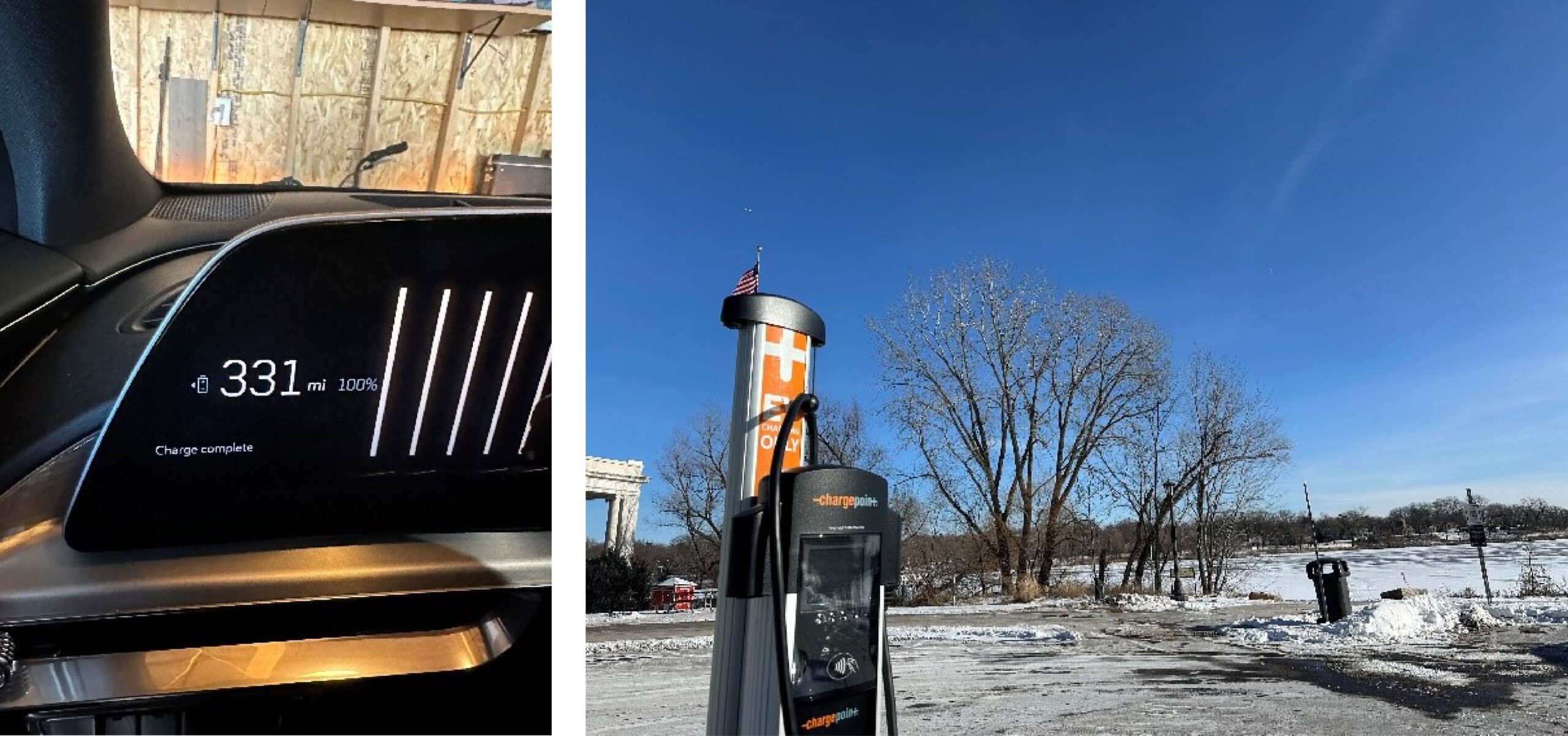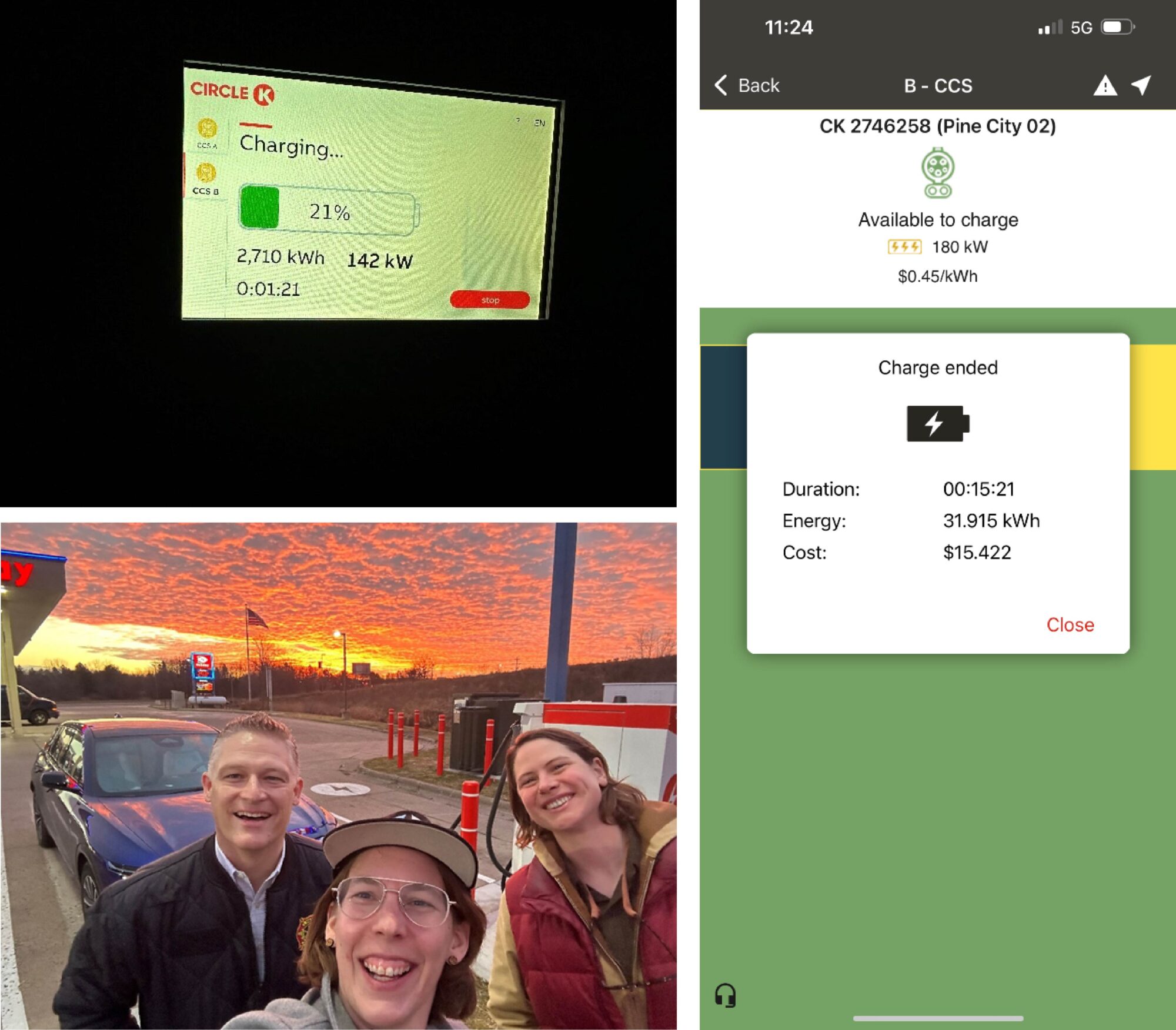
Electric vehicles, they’re all around us! And if Super Bowl commercials are to be believed, we’re going to be seeing more and more on the road soon. Personally, I’m a soccer fan, but even my ears perk up when I hear there were 59 electric vehicle (EV) commercials during the big game – wild!
I’m a new EV owner myself and have spent the past few months getting the hang of things. So far, I have made four trips from Saint Paul to Duluth with my EV and have learned a lot about the rhythm of driving an EV over longer distances than my regular commute. Minnesota has come a long way in charging infrastructure, and we now have a wide range of electric vehicles to choose from to meet our different transportation needs. This blog post is just one snapshot of what is available and things I’ve learned about driving and charging my EV in Minnesota.
I live in Saint Paul and have family in Duluth, and I had been waiting for an electric vehicle that has the range and comfort to get me there and back without extensive charging detours. Different electric vehicles have different purposes, so my partner and I were looking for an EV that we could take on road trips. We landed on a 2024 Cadillac Lyriq AWD that holds a 102kWh battery and a 300–330-mile range depending on the weather and amount of highway driving. It’s a comfortable and smooth ride with great safety features for carrying precious canine cargo.

It’s important to note that we have Level 1 charging off a standard outlet at home and primarily use Level 2 charging around Saint Paul (need a refresher on the different levels of EV chargers? Read our explainer about it!). Target grocery shopping, a walk around Lake Como, and the occasional Goodwill run give us regular free or cheap energy to meet almost all our transportation needs.
Here are five things I’ve learned about driving an electric vehicle longer distances around Minnesota so far:
1. Charge to 100% before you leave home.
This seems like a no-brainer but is easy to overlook if you are busy preparing to hit the road. For battery health it is recommended to only charge your car to 80% for daily use, so getting that extra 20% for a longer road trip required some planning on my part. That looked like a Lake Como walk to take advantage of the $1 per hour charging and plugging in at home overnight. Take a look at your local charging options (and/or your home charger) to fill your battery before your big trip.

2. Your speed matters.
Your energy usage is exponential, so going 68 mph instead of 70 mph makes a small but helpful difference in range. Count this as another reason to never go over the speed limit. My efficiency reading went from 2.1 miles per kWh to 2.6 miles per kWh with this simple speed change. For this trip, that adds up to nearly 50 extra miles of highway driving!

3. Fast charging speeds vary.
Always check the charging speed of fast chargers to find the fastest available charger on your trip. I’ve seen everything from 25kW to 180kW. For a Saint Paul to Duluth trip, there is a 180kW charger in Pine City that has given me over 140kW of charge speed. Don’t forget that the time to charge your battery slows as you get closer to 100%. On the way north, getting from about 60% to 75% took 20 minutes. On the way home we went from about 20% to 50% in 15 minutes.

4. Chargers can be anywhere and make for great activity stops, but we need more!
So far, my favorite charging stop is in Duluth’s Lincoln Park Craft District where you can get coffee, food, and stop at a few shops while your car charges. Moose Lake Brewing also has a charger nearby where you could stop in for a snack and bring some craft beer home. You might be surprised at how many businesses have charging available along your stops, and this will only get easier as more places provide EV charging.

5. ABC – Always Be Charging.
Electric vehicle charging is more about taking regular sips rather than periodic gulps of energy. Instead of waiting until my battery was almost dead and filling it up to 100%, I’ve learned to simply charge it when it’s parked along my journey. When I shifted the way I plan, everything clicked into place. Charging at home and parking at chargers when you’re running errands or out for an activity made planning easier and made me less reliant on fast chargers during my trips.

Lots of folks in Minnesota are ditching gas cars for electric vehicles. They’re better for our health, the environment, and honestly, they’re a blast to drive. With EV sales booming and tech getting better and better every year, you’ll see more of them on the road with improved charging stations, too. As more Minnesotans hop on the EV train, the charging setup will only get better.
Take it from me: I’ve driven my EV on a handful of long winter trips in Minnesota without a hitch. If I can do it, so can you.
I hope this post gave you some helpful tips as we steer toward a clean, decarbonized future in Minnesota.
